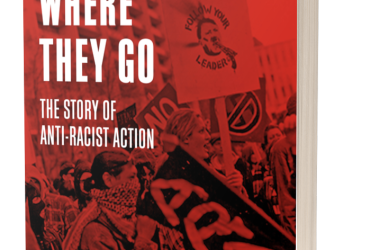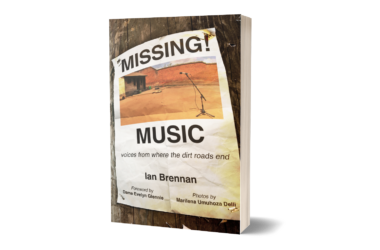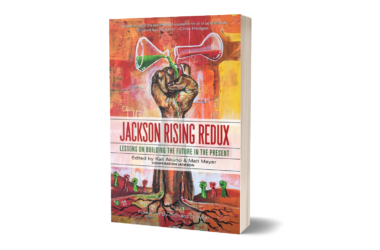By Kimberly Croswell, University of Victoria
Anarchist Developments in Cultural Studies
May 2021
Liberating Sápmi: Indigenous Resistance in Europe’s Far North is a col- lection of twelve interviews with a number of well-known Sámi pub- lic figures, including artists, activists, and scholars. It is foregrounded by a preface and critical history of the Sámi people by noted anar- chist author/translator Gabriel Kuhn. Kuhn’s research is meticulous, and his questions are insightful. He has assembled a diverse group of spokespeople to articulate the past, present and future of the Sámi. Kuhn draws on topics and responses raised during the interviews
to create a themed dialogue between the participants. And, nestled between the interviews, the book features poetry, speeches, art, and documentary films/photography responding to crucial moments of resistance and assertations of Indigenous autonomy.
The term Sápmi encompasses both the Sámi homeland and a way of living with the land, traditional ways of being, life, culture, and spiri- tuality. As such, the book’s title, Liberating Sápmi, “evokes the libera- tion of not only a territory, but of a people.”1 The lands under discus- sion encompass a vast circumpolar region in northern Europe and cross four state entities: Norway, Sweden, Finland, and Russia. Thus, Sápmi is said to have four ‘sides.’ Sámi history spans millennia and includes a record of invasion, colonisation, and assimilation by the four state actors whose borders the Sámi must now navigate to fulfill their lifeways. Reindeer herding is the core cultural practice the Sámi are known for, but not all Sámi herd reindeer and there are spiritual, healing, and socio-economic dimensions to their way of life that are also important. Furthermore, the majority of Sámi are urban dwell- ers. Interestingly, Kuhn notes with surprise how little mainstream Scandinavian societies know about the Sámi: additionally, the Sámi have faced antipathy from the region’s socialist-inclined leftists be- cause, in the context of industrial ‘progress,’ leftists have (more often than not) opposed their defence of the ecological integrity of their lands. The primary industrial marker of leftist ‘progress’ has been a boom in hydroelectric dams, which not only impacts negatively on reindeer herding travel routes, but also disrupts salmon habitats. Presently, the most telling fight opposes wind farms, which also ob- struct reindeer herding migration routes. That being said, ‘traditional and contemporary’ go hand in hand in Sámi life systems, which have evolved to include the use of technology (tracking devices, snowmo- biles, and helicopters) whilst attending to the revitalisation of tradi- tional songs (luohti, aka joik) and other practices.
There are two sides in the struggle against colonialism: anti-colonial resistance and decolonising/renewing cultural values. Colonial en- croachment of Sápmi territories has evolved over centuries without any signing of treaties and resistance is ongoing. Each interviewee understood their connection to their territories as a situated present- ness in terms of relationships. Habitation for Sámi people includes the freedom to traverse state-created borders and a cosmopolitan, global understanding of Indigeneity. An important thread running through all the interviews was a question posed by Kuhn regarding regional self-determination, and how it can be realized. Overwhelm- ingly, the respondents asserted Sápmi self determination does not entail a drive for statehood, but towards autonomy and self-gov- ernance. Kuhn provides examples of autonomous self-governance struggles the Sámi might look to, from the Zapatistas in Mexico to Kurdish Democratic Confederalism in Rojava. He also references the independent administrative autonomy exercised by the Inuit in Nunavut, Canada as a possible model for the Sámi to adapt. Another is the islands of Åland occupied by Swedish speakers: whilst techni- cally under Finnish rule, islanders operate their affairs autonomous- ly.2 Such examples could be emulated, and Kuhn’s interviewees bring considerable knowledge and experience to bear on this issue.
Interviews
Having enjoyed her music since the early 2000s, I started my explo- ration with the remarks of renowned Sámi musician Marie Boine. Boine’s voice is her gift to the world. As a recording artist, Boine blends traditional luohti (a.k.a, yoik) with other musical styles, creat- ing a unique fusion that is both Sámi and global. Indeed, her cultural prominence has led many to regard her as the unofficial ‘world ambassador’ of the Sámi. Now an elder in her community, Boine feels a pressing responsibility to guide the youth by sharing stories, which she does.
From the interview I learned Boine’s religious upbringing in a strict Pietist Læstadian community (a blended Sámi-Christian sect that rejects the ‘old ways’) determined she only learned the truth con- cerning an important conflict in Sámi/Norwegian history — the 1852 Kautokeino Rebellion (in Sámi, the Guovdageaidnu Rebellion) — in 2008, while working on the soundtrack for Nils Gaup’s film on the subject. The Guovdageaidnu Rebellion involved the killing of a Norwegian merchant and a government agent by approximately fifty Sámi; two rebel leaders were executed, and twenty others were sentenced to forced labour. Fourteen years later, those convicted were finally pardoned. Many Pietist Læstadian are ashamed of this event and actively repress any memory of it, which speaks to Boine’s personal experience of the erasure of her people’s history.
Marie Boine also discussed declining to participate in the 1994 Olympic Opening Ceremonies in Lillehammer, Norway. She refused to be a tokenised ‘decoration’ for the event, stating to national and international media that Norwegian society does not sufficiently re- spect Sámi rights. Her refusal shocked the government: one cabinet minister called her ‘arrogant,’ an epithet Boine took great exception to. Though she refused to participate, Boine respects the Sámi per- former who took her place in the Opening Ceremonies, observing that, ‘exotified’ in traditional Sámi dress and accompanied by a live reindeer, Nils-Aslak Valkeapää still performed a strong yoik.3
The next interview I gravitated towards was a conversation with visual artist and reindeer herder Anders Sunna. Considered the fore- runner of contemporary political Sámi art, Sunna’s paintings (two examples are reproduced) have been immensely influential on young Sámi creators. According to Sunna, art produces a message that can quickly travel beyond the boundaries of any language. Like Boine Sunna draws inspiration from non-Sámi art, but “always with Sámi eyes.”4 In this way, he contributes to a living Sámi culture that is open to the world. To express his sense of impending social confrontation, which he feels is immanent under existing conditions of oppression, Sunna deploys militant visual imagery, including weaponry, balacla- vas, and barricades.
In fact, rebellion is rife in Sunna’s art and life. He has had first-hand experience of his family’s dispossession and betrayal, both by colo- nial forces and by Sámi opportunists who benefit from colonialism. Sunna’s family has been in conflict with the Swedish state since the early 1970s (although the issue had been simmering since the 1930s). In Sweden, non-Sámi hobbyists can own and ‘herd’ reindeer, but Sámi have often ended up doing the actual work without payment. In fact, at times, Sámi caught up in such arrangements have been forced to pay Swedish colonizers for the use of lands to herd non-Sá- mi reindeer. Sunna’s family refused to participate in such exploitation and members of their sameby (a reindeer herding guild/association made up of a community of families, with a designated territorial range) informed the Swedish authorities. Because the family spoke up against injustice, repression ensued, and they were excluded from their traditional herding grounds. As a result, the family were forced to illegally guerilla-herd their reindeer outside their sameby’s herding range for over forty years. Additionally, there were attempts to forc- ibly cull the family herd and reindeer were stolen. On the pettiest of levels, Sunna recalls his family could not trust their Sámi neighbours when he was growing up. The family was constantly harassed, with incidents such as slashed tires and discriminatory acts against the children during school. He remembers waiting for family members to return from herding with trepidation, fearing they might be shot. Given this oppression, Sunna flatly states it is “impossible to iden- tify with it [Swedish society].”5 Nor does he trust the officialdom of the Sámi community, as neither the National Association of Sámi in Sweden6 nor the Sámi Parliament7 have come to the aid of his fam- ily in their struggle for justice. Sunna regards both institutions as colonised: their focus is on the exploitation of natural resources and political power brokering.
Despite these challenges, Sunna sees the political struggle for Sámi self-determination, territorial autonomy, and resurgent lifeways as a long-term ‘marathon’ of resistance. Most importantly, Sunna seeks unity for the four aspects of Sámi, so as to transcend divisive state- based institutions. He ends his interview on a hopeful note, stating the right steps to take moving forward are to “respect one another, help one another, create unity.”8
Sunna’s paintings imagine burgeoning social tensions, and the Sámi are no strangers to militant direct action, as recounted by Nillas Somby, a reindeer herder, sailor, photographer, journalist and Indig- enous sovereignty activist. Somby has been a prominent figure in the struggle for Sámi social justice since the 1970s, however, his incred- ible history begins not with himself, but with a relative, Mons Aslak- sen Somby, one of the two leaders of the Guovdageaidnu Rebellion who were executed in 1854. Nillas Somby spent many years navigat- ing colonial red tape to retrieve his relative’s remains and give him a proper burial, which finally happened in 1997. Somby’s own acts
of rebellion began with the Áltá conflict (1979-1982) that contested plans for a hydroelectric dam on the Áltá-Guovdageaidnu river that had been in the works since 1968. Popular outcry led the Norwegian government to scrap the massive dam, but a proposal to build a pow- er station on the river remained. In response, a solidarity/resistance movement involving Sámi, Norwegians, and international support- ers emerged and in 1979 a protest camp was erected at “Nullpunktet” (Point Zero), on the site where the power station was to be built. This encampment was maintained throughout the winter, despite police attempts to clear it. The leading group spearheading this protest was Folkeaksjonen (People’s Action, founded 1978). Somby recalls Folkeaksjonen was not a Sámi organisation and it focussed solely on protecting the river (Sámi, of course, were also defending the river’s well-being within a larger context). Awakening Folkeaksjonen con- cern for Sámi rights entailed considerable dialog between Sámi and Norwegians. Members of the Norwegian ‘left’ participated in the movement, but they were not in control, so the Sámi had room to assert themselves. The most significant exercise in outreach to Nor- wegians unfolded in Oslo. There Sámi erected a lávvu (a traditional tent) outside Norway’s parliament and occupied the site to rally support for their cause. Somby was at this occupation, where he and many others conducted a hunger strike in 1979.
In 1982, the Norwegian Supreme Court upheld the government’s decision to construct the power station. In response, Somby and two others decided to take direct action and sabotage a bridge leading to the construction site. Intending to only do minor damage, they built and planted a small bomb as a symbolic form of “street theatre.”9 Unfortunately the bomb malfunctioned and when Somby investi- gated, it blew up: he lost an arm and an eye. Subsequently, Somby and collaborator John Reier Martinsen were imprisoned for arson, a charge that carried a maximum sentence of 21 years.10 Kuhn’s inter- view details a dramatic story in which Somby escapes to Canada us- ing a false passport. Upon arrival he was sheltered by two Indigenous communities, initially on unceded WSÁNEC territory on Vancouver Island. Somby was also adopted into the Nuxalk Nation of the Bella Coola valley (on the coastal mainland of British Columbia). Aided by this support, he remained underground for two years before be- ing deported back to Norway. Having little faith in Sámi participa- tion in Norwegian governance or consultations involving Norway’s Sámi Parliament, Somby advocates Sápmi decolonisation through the exercise of traditional Sámi spirituality, a relation with the land rooted in “understanding how everything is connected, about being able to relate to nature and be its guardian.”11
Conclusion
Gabriel Kuhn’s Liberating Sápmi: Indigenous Resistance in Europe’s Far North is an enriching introduction to Sámi resistance struggles. As the interviews make clear, Sámi self-determination lies in the assertion of autonomy from the four nation states laying claim to Sá- pmi. Struggling for autonomy, the Sámi are renewing their lifeways and cultural practices while challenging cooptation into the nation- alist narratives of Norway, Sweden, Finland, and Russia. The fight for Indigenous self-governance has many fronts: Liberating Sápmi: Indig- enous Resistance in Europe’s Far North is testimony to the strength, resilience, and determination of the Sámi people.
Notes
1 Gabriel Kuhn, “Preface,” Liberating Sápmi: Indigenous Resistance in Europe’s Far North, ed. Gabriel Kuhn (Oakland, CA: PM Press, 2020), x.
2 Gabriel Kuhn, “Introduction,” Liberating Sápmi, 40-41.
3 Marrie Boine, in Liberating Sápmi, 93-100.
4 Anders Sunna in Liberating Sápmi, 153.
5 Sunna in Liberating Sápmi, 160.
6 Founded in 1950. See “Association of Swedish Sámi”: https://websie.cefe.cnrs.fr/ boazu/swedish-sami-association/
7 The government of Sweden established an elected Sámi parliament in 1993, fol- lowing Norway’s founding of a Sámi parliament in 1989. Finland preceded both with an electoral body representing the Sámi dating to 1973 that was transformed into a parliament in 1995. In Russia, Sámi established the Kola Sámi Assembly in 2010 (named after the Kola peninsula which forms part of Sápmi). The Assembly is not recognised by the Russian Federation.
8 Sunna in Liberating Sápmi,158.
9 Nillas Somby in Liberating Sápmi, 59.
10 The third participant in the bombing escaped capture and has never been iden- tified.
11 Somby in Liberating Sápmi, 66.

Gabriel Kuhn is an author, translator, and union activist. He has published widely in English and German. His texts have been translated into more than a dozen languages.






